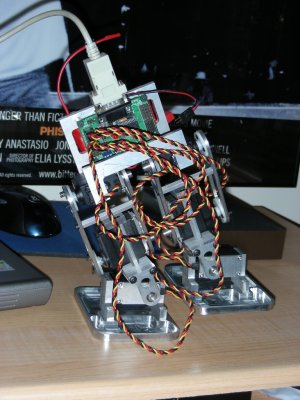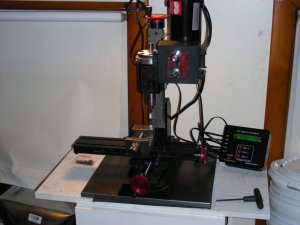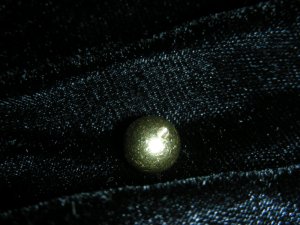
Morbo is a biped robot I designed and built to experiment with. It is intended to be a continually developing platform to test various methods of locomotion and processing. Although there are currently several biped kits on the hobby market, I've decided to " roll my own " so to speak. I love machining and building, and I have a few things I haven't seen before that I'd like to try.
The above picture shows Morbo in almost the current configuration. Missing in that picture is the wireless link. The current incarnation consists of:
6 Hitec 475HB Servos
PicoPic
Serial Servo controller
Sparkfun Electronics Blue SMiRF
Bluetooth radio
Custom build aluminum chassis
1500Mah 7.4v LiPo Battery
Medusa Electronics 3.5A BEC
The link at the left has some very dark low res video of Morbo's first step. Not enough light, and not the right settings on the camera. I promise I'll do a better job next time. So where to from here? Although I am excited that I have a walking platform, there is much to be desired about the current chassis. It's fairly heavy for one thing, some habits from combat robots are hard to break. Although the rear servo brackets are one way to completely support joints, they make a lot of trouble aligning things, and also add to excess weight. The weight is also spread throughout the leg, making it more difficult to position the leg that's off the ground. To address these issues I have redesigned the chassis with the following in mind : |
 |
Here is the upgrade to the Sherline mill. It's served me well when I didn't have access to another larger mill, now I plan to do more work at home with it. They are tremendously capable for their size, and have many upgrades available including the one I just installed, the DRO or Digital Read Out kit. On larger size mills a digital readout uses scales to read the absolute position of the table. On this mill optical encoders read the turns of the lead screw with a programmed compensation for leadscrew backlash. There's a lot of talk online about the limitations of such a system, but like it or not backlash is a reality when dealing with leadscrew systems like this one, no matter what. The only way out would be to install ballscrews, but that's a whole lot of cost for a machine that can be just as accurate if you take your time and know what you are doing, working around the backlash. The digital readout on the other hand makes life a whole lot easier if not for the fact that it frees me from having to remember turns of the handwheel. I've gotten really used to this system on the Bridgeport at work, it makes things a whole lot easier. I also mounted the mill itself to a heavy steel base plate. The extra mass should help with stability, as well as making a handy place to attach magnetic bases for holding indicators. I took the opportunity to give the mill a thorough cleaning as well. Now that I have a capable mill and lathe set up at home, prepare to be bombarded with pictures of machining in progress. |
 |
Today I made the spiders that go in the middle of the " U " joints. I started out with brass balls from my favorite supplier of all time www.mcmaster.com. A 2-56 hole was drilled and tapped in the ball to begin the process. |